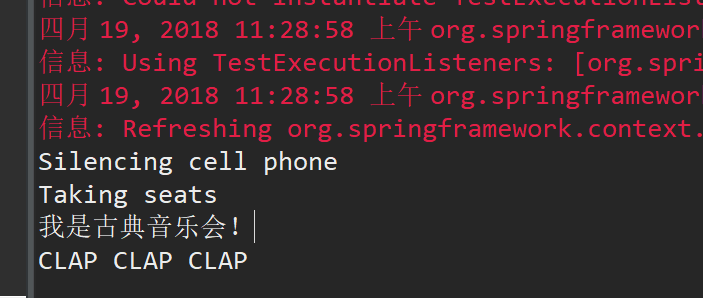笔记7 AOP练习<有疑问>
场景描述:
核心业务:举行一场古典音乐会。
周边功能:观众入场,关闭手机、落座,觉得音乐好听时鼓掌,觉都不好听则退票。(切面)
1.编写切点(切点用于准确定位应该在什么地方应用切面的通 知)————即核心业务
首先定义一个Performance接口:
package concert;
public interface Performance {
public void perform();
}
2.定义切面,即编写Audience.java。
Audience类使用@Aspect注解进行了标注。该注解表明Audience不仅仅是一个POJO,还是一个切面。
@Pointcut注解能够在一 个切面内定义可重用的切点。
也可以在通知注解中直接使用切点表达式。
package concert; import org.aspectj.lang.annotation.AfterReturning;
import org.aspectj.lang.annotation.AfterThrowing;
import org.aspectj.lang.annotation.Aspect;
import org.aspectj.lang.annotation.Before;
import org.aspectj.lang.annotation.Pointcut;
import org.springframework.stereotype.Component; @Aspect
@Component
public class Audience {
@Pointcut("execution(** concert.Performance.perform(..))")
public void perform() { } // @Before("execution(** concert.Performance.perform(..))")
@Before("perform()")
public void silenceCellPhones() {
System.out.println("Silencing cell phone");
} // @Before("execution(** concert.Performance.perform(..))")
@Before("perform()")
public void takeSeats() {
System.out.println("Taking seats");
} // @AfterReturning("execution(** concert.Performance.perform(..))")
@AfterReturning("perform()")
public void applause() {
System.out.println("CLAP CLAP CLAP");
} // @AfterThrowing("execution(** concert.Performance.perform(..))")
@AfterThrowing("perform()")
public void demandRefund() {
System.out.println("Demanding a refund");
}
}
Audience有四个方法,定义了一个观众在观看演出时可能会做的事 情。在演出之前,观众要就坐(takeSeats())并将手机调至静音 状态(silenceCellPhones())。如果演出很精彩的话,观众应 该会鼓掌喝彩(applause())。不过,如果演出没有达到观众预期 的话,观众会要求退款(demandRefund())。 这些方法都使用了通知注解来表明它们应该在什么时候调用。

在这里也可以使用环绕通知,环绕通知是最为强大的通知类型。它能够让你所编写的逻辑将被通知 的目标方法完全包装起来。实际上就像在一个通知方法中同时编写前 置通知和后置通知,代码如下:
@Around("performs()") // 环绕通知方法
public void watchPerformance(ProceedingJoinPoint jp) {
try {
System.out.println("Silencing cell phone");
System.out.println("Taking seats");
jp.proceed();
System.out.println("CLAP CLAP CLAP");
} catch (Throwable e) {
System.out.println("Demanding a refund");
}
}
在这里,@Around注解表明watchPerformance()方法会作 为performance()切点的环绕通知。ProceedingJoinPoint作为参数。这个对象是必须要有的,因为要在通知中通过它来调用被通知的方法。通知方法中可以做任何的 事情,当要将控制权交给被通知的方法时,它需要调 用ProceedingJoinPoint的proceed()方法。
<可以不调用proceed()方法,从而阻塞对被通知方 法的访问,与之类似,也可以在通知中对它进行多次调用。要这样 做的一个场景就是实现重试逻辑,也就是在被通知方法失败后,进行 重复尝试。>
3.定义Java配置文件ConcertConfig.java,使用Spring自动装配。在Java配置文件中启用AspectJ注解的自动代理。
AspectJ自动代理都会为使 用@Aspect注解的bean创建一个代理,这个代理会围绕着所有该切面 的切点所匹配的bean。
package concert; import org.springframework.context.annotation.ComponentScan;
import org.springframework.context.annotation.Configuration;
import org.springframework.context.annotation.EnableAspectJAutoProxy; @Configuration
@EnableAspectJAutoProxy // 启用AspectJ自动代理
@ComponentScan
public class ConcertConfig { }
也可以定义XML配置文件
在Spring中要使用XML来装配bean的话,那么需要使用Spring aop命名空间中的<aop:aspectj-autoproxy>元素启用自动代理。
<?xml version="1.0" encoding="UTF-8"?>
<beans xmlns="http://www.springframework.org/schema/beans"
xmlns:xsi="http://www.w3.org/2001/XMLSchema-instance"
xmlns:aop="http://www.springframework.org/schema/aop"
xmlns:tx="http://www.springframework.org/schema/tx"
xmlns:context="http://www.springframework.org/schema/context"
xmlns:c="http://www.springframework.org/schema/c"
xsi:schemaLocation="
http://www.springframework.org/schema/beans
http://www.springframework.org/schema/beans/spring-beans-3.0.xsd
http://www.springframework.org/schema/aop
http://www.springframework.org/schema/aop/spring-aop-3.0.xsd
http://www.springframework.org/schema/tx
http://www.springframework.org/schema/tx/spring-tx-3.0.xsd
http://www.springframework.org/schema/context
http://www.springframework.org/schema/context/spring-context-3.0.xsd">
<context:component-scan base-package="concert"></context:component-scan>
<aop:aspectj-autoproxy></aop:aspectj-autoproxy> <!--启用自动代理-->
<!-- <bean class="concert.Audience"></bean>
<bean class="concert.Classcial"></bean> -->
</beans>
注:在使用XML进行装配的时候,如果在XML声明了bean后,一定要去掉两个bean原来的@Component注解,且不用使用自动代理;如果不在XML文件中声明bean,在Audience和Classcial中添加@Component注解,则可以启用自动代理。
4.编写测试文件ConcertTest.java
package concert; import org.junit.Test;
import org.junit.runner.RunWith;
import org.springframework.beans.factory.annotation.Autowired;
import org.springframework.test.context.ContextConfiguration;
import org.springframework.test.context.junit4.SpringJUnit4ClassRunner; @RunWith(SpringJUnit4ClassRunner.class)
@ContextConfiguration(classes = concert.ConcertConfig.class)
public class ConcertTest {
@Autowired
private Performance perform; @Test
public void test() {
perform.perform();
}
}
疑问:在进行测试时,只能定义接口的对象来进行测试,定义接口的实现类对象时就会报错。
5.结果
两种配置方式结果一样

笔记7 AOP练习<有疑问>的更多相关文章
- Spring笔记:AOP基础
Spring笔记:AOP基础 AOP 引入AOP 面向对象的开发过程中,我们对软件开发进行抽象.分割成各个模块或对象.例如,我们对API抽象成三个模块,Controller.Service.Comma ...
- Spring学习笔记之aop动态代理(3)
Spring学习笔记之aop动态代理(3) 1.0 静态代理模式的缺点: 1.在该系统中有多少的dao就的写多少的proxy,麻烦 2.如果目标接口有方法的改动,则proxy也需要改动. Person ...
- 笔记13 AOP中After和AfterReturning的区别
AOP中 @Before @After @AfterThrowing@AfterReturning的执行顺序 public Object invoke(Object proxy, Method met ...
- 笔记9 AOP练习3(通过注解引入新功能 )
切面可以为Spring bean添加新方法. 在Spring中,切面只是实现了它们所包装bean相同接口的 代理.如果除了实现这些接口,代理也能暴露新接口的话,会怎么样 呢?那样的话,切面所通知的be ...
- Spring笔记(三)AOP前篇之动态代理
AOP思想是将程序中的业务代码与服务代码进行分离,在运行时进行结合.比较强调程序的层次结构,是一种面向切面的编程.而在AOP实现的底层主要用到了动态代理,而动态代理又分为JDK动态代理和CGLIB动态 ...
- Spring学习笔记之AOP配置篇(一)
[TOC] 1. 创建并声明一个切面 首先,创建一个类,添加@Component注解使其添加到IoC容器 然后,添加@Aspect注解,使其成为一个切面 最后,在配置文件里面,使用<aop:as ...
- 笔记7 AOP
1. 通知(Advice) 切面的工作被称为通知.通知定义了切面是什么以及何时使用.除了描述切面要完成的工作, 通知还解决了何时执行这个工作的问题.它应该应用在某个方法被调 用之前?之后?之前和之 ...
- Spring学习笔记4——AOP
AOP 即 Aspect Oriented Program 面向切面编程 首先,在面向切面编程的思想里面,把功能分为核心业务功能,和周边功能. 所谓的核心业务,比如登陆,增加数据,删除数据都叫核心业务 ...
- [Spring学习笔记 4 ] AOP 概念原理以及java动态代理
一.Spring IoC容器补充(1) Spring IoC容器,DI(依赖注入): 注入的方式:设值方法注入setter(属性注入)/构造子注入(构造函数传入依赖的对象)/字段注入Field(注解) ...
随机推荐
- java 注解的实现机制
一.什么是注解: 注解是标记,也可以理解成是一种应用在类.方法.参数.属性.构造器上的特殊修饰符.注解作用有以下三种: 第一种:生成文档,常用的有@param@return等. 第二种:替代配置文件的 ...
- php中(包括织梦cms)set_time_limit(0)不起作用的解决方法
背景介绍: 在做织梦冗余图片清理的功能时, 由于冗余图片太多,导致每次清理时都会超时, 后来在网上搜索了各种文章,网上有如下的解决方法: set_time_limit(0) ini_set('max_ ...
- 教你在不使用框架的情况下也能写出现代化 PHP 代码
我为你们准备了一个富有挑战性的事情.接下来你们将以 无 框架的方式开启一个项目之旅. 首先声明, 这篇并非又臭又长的反框架裹脚布文章.也不是推销 非原创 思想 .毕竟, 我们还将在接下来的开发之旅中使 ...
- JS页面跳转的常用方法整理.
<script type="text/javascript"> //js页面跳转 function showtabs() { window.location.href ...
- NoSQL简介
相信大家也多多少少了解过一些数据库,最常用的当属MySQL了,当然也这是关系型数据库的代表了 常见的关系型数据库有:MySQL.SQLServer.Oracle 而数据库也有另一个流派-----NoS ...
- Spring Security入门(3-1)Spring Security的登录页面定制
- I/O和管道
一:I/O设备 I/O(Input/Output),即输入/输出,通常指数据在内部存储器和外部存储器或其他周边设备之间的输入和输出. 标准输入(STDIN):0 默认接受来自键盘的输入 标准输出(ST ...
- WPF利用附加属性修改ShowGridLines效果
1.思路主要代码 wpf的gridline原本效果是虚线类型的.有时候需要设计成表格形式的,因此有了用附加属性来自动绘制边框线的想法. 思路:绘制Line并添加到grid的children里,但效果并 ...
- Chrome浏览器vue-devtools插件安装教程
1.打开https://github.com/vuejs/vue-devtools,cmd方式直接输入:git Clone https://github.com/vuejs/vue-devtools. ...
- Maven 本地仓库明明有jar包,pom文件还是报错解决办法
方法一: 找到出错的jar包文件位置,删掉_maven.repositories文件 方法二: maven中的本地仓库的index索引没有更新导致 解决方案: 在eclipse中打开菜单 window ...
